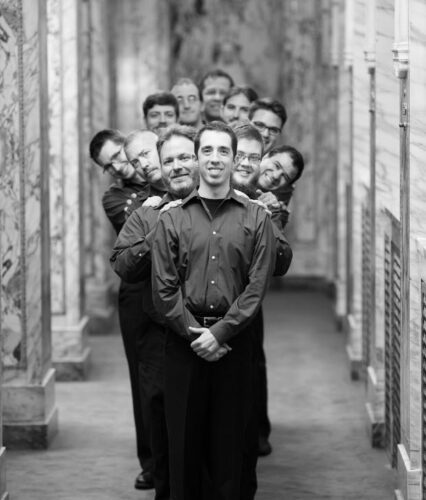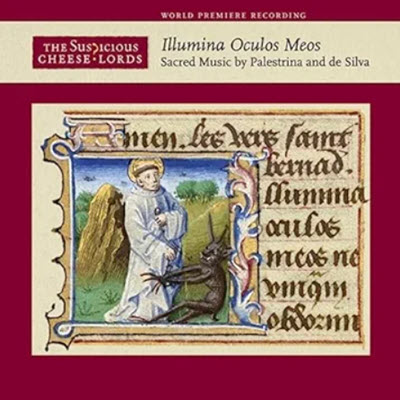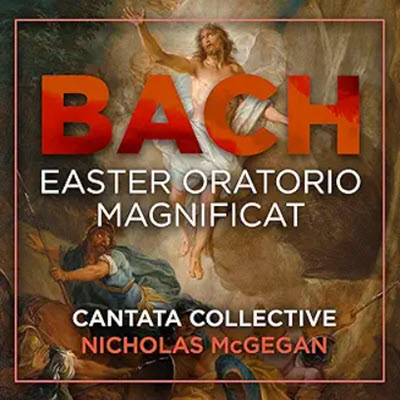by Karen M. Cook
Published October 30, 2023
Illumina Oculos Meos: Sacred Music by Palestrina and de Silva. Suspicious Cheese Lords. SCL-505

Giovanni Pierluigi da Palestrina (c.1525–1594) hardly needs an introduction to the broad audiences of Early Music America. A composer with significant posthumous renown, Palestrina occupies a central role in Western music history and in today’s conceptualization of “early music.” It is therefore quite surprising to realize that many of his works remain unrecorded.
Enter the Suspicious Cheese Lords, a Washington, D.C.-based ensemble who task themselves with bringing to light lesser-known works alongside their more famous relatives. (Their memorable name is a silly in-joke translation of Tallis’ motet Suscipe quaeso Domine, where “suscipe” doesn’t mean “suspicious” and “quaeso” sounds like the Spanish word for “cheese.”)
On this, their fifth album, the Lords focus on previously unrecorded works of Palestrina, complemented by works by his Roman peers Andreas de Silva (fl. 1510–1530) and Francesco Soriano (1548 or 1549–1621).
At the heart of the album is Palestrina’s Missa Illumina oculos meos, and the motet by de Silva on which it is based. Unusually lengthy, de Silva’s motet is structured in three parts, the outer two of which are set for six voices. Its haunting opening slowly builds through long, stretched-out passages and lots of deceptive motion that stave off the cadences. The composer’s careful attention to text plays out through lovely shifts of mood and meter. Palestrina’s Mass was copied alongside the Missa Papae Marcelli, but it wasn’t published until after Palestrina’s death, by which time its famed contemporary had already (and perhaps unfortunately) overshadowed many of his other works.

In the Missa Illumina oculos meos, Palestrina picks out all the juiciest and most recognizable bits from de Silva and elaborates on them, reinforcing the meaning of the Mass text with music borrowed from significant moments in the motet. That haunting opening, for example, is present right from the start in the Kyrie, and returns in various ways throughout the rest of the Mass. One of the perks of writing for six voices, as composers such as Palestrina understood, is being able to play with all sorts of different kinds of textures and groupings. The reverberant acoustic of the recording means that the group is well served by smaller groupings, which permit a bit more clarity of individual line. The three-voice section at “Fac mecum,” or the all-too-fleeting duet at “Periit fuga,” allow individual voices to shine, and the reduced textures of the Benedictus, with its whirling eddies of upper voices, is one of the highlights of the disc.
Of the remaining six tracks by Palestrina, five are offertories, short and sweet, full of imitative lines and interwoven voices, all in the service of the text. Opening the album, Sperent in te builds nice momentum throughout, especially in the faster “Psallite Domino.” And Sacerdotes Domini is beautifully restrained, at least until the vibrant concluding “Alleluia.” The sixth and last work is his Magnificat Secundi Toni, the lengthiest track on the recording; its stellar opening leads into a beautiful set of ascending passages, with an upper-voice melody layered over top of the action like icing on a cake.
The motet and Mass might be the heart of the recording, but the Magnificat is not to be missed. Palestrina likely wrote it while at St. John Lateran and, in a connection with that famous Roman church, the last track on the recording is by Francesco Soriano, a singer under Palestrina’s direction there. Soriano’s eight-voice motet Laetare Jerusalem ends the album on an emphatic note of rejoicing, and may we listeners rejoice too, to have the opportunity to hear so many of these works for the first time, and performed so well.
Karen M. Cook is Associate Professor of Music History at the University of Hartford. She specializes in late medieval music theory and notation, focusing on developments in rhythmic duration. She also maintains a primary interest in musical medievalism in contemporary media, particularly in video games. For EMA, she recently wrote ‘Early Music Rocks the Video Game Universe.’




